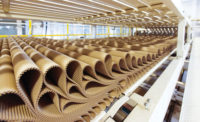Machinery
The Skills Gap: Is Packaging Half-Full or Half-Empty?
As suppliers design end-of-line equipment to meet today’s packaging needs, the industry holds great promise to close the skills gap.






Are you a glass half-empty or glass half-full kind of person? Your answer will shape how you view online search results for “manufacturing skills gap.”
“Skills gap is worsening in U.S. manufacturing industry” paints a rather dire view on the state of manufacturing for the glass half-empty people, whereas the headline: “Addressing the skills gap in manufacturing” indicates that a more proactive problem-solving approach is occurring for the glass half-full crowd.
For the past several years a skills gap has existed in manufacturing, as well as the packaging industry. Finding enough qualified people to operate case packing equipment, robotics, pick-and-place and other end-of-line systems is challenging. This has led some suppliers to revamp their machinery to make it more user-friendly to reflect this changing workforce.
While labor shortage is causing some short-term pains, long-term career opportunities and paths to success within packaging definitely make this a glass half-full industry.
The Skills Gap
Just how big is the skills gap in manufacturing and packaging? According to the Bureau of Labor Statistics, there were more than 500,000 open jobs in manufacturing as of August 2018. And that figure is estimated to grow as high as 2.4 million unfilled jobs by 2028, according to research by Deloitte and The Manufacturing Institute.
Not surprising, open jobs in packaging follow this trend as well. The Packaging School estimates there are currently about 110,000 unfilled jobs in the packaging industry, and that figure is expected to grow in the coming years. There are many reasons for this gap, but certainly the retirement of baby boomers, combined with the lack of trained workers in the pipeline, is a leading cause. This is a predicament among end-user companies as they look to maintain or speed up production in an economy that’s growing, but to do so with a less-experienced workforce.
Recognizing this need from companies, equipment suppliers are redesigning end-of-line packaging machinery, such as case packers, that is more user-friendly and intuitive to operate and maintain.
“Smarter” Changeovers
One of the newer developments is found during changeovers. Completing changeovers in older case packing equipment placed the onus on the operator to ensure adjustments and calculations were done correctly. This process of accurately dialing-in equipment often came with years of experience in performing changeovers for different SKUs — knowledge that couldn’t be gained overnight.
Today, case packaging equipment is more intelligent and can accomplish much of the fine-tuning associated with changeovers itself. For example, changeover verification guides operators through the changeover process. When completed, if any setting is off for a specified recipe, the case packer alerts the operator to the area of error for attention. This design provides for more accurate and repeatable changeovers, while reducing the likelihood of damage to the machine from an incorrect adjustment.
Formalized Training Programs
Another area where the skills gap is influencing equipment design is in the area of maintenance. Shrinking staffs means companies likely have fewer true machine operators with the background and skills to troubleshoot and maintain equipment. The art of troubleshooting is a special skillset of employees that many companies just don’t have on staff anymore.
As a stop-gap measure, some companies bring in temporary help to run and maintain equipment. While it addresses a short-term need, temporary workers occasionally lack a deep understanding of the maintenance requirements, and these shortcomings may shorten the life of specific machinery.
Many companies are investing in training the employees they do have, knowing that well-maintained equipment is the key to their survival. Formal training programs typically involve both classroom and hands-on training of case packing equipment and are offered by reputable suppliers. Geared toward operators, maintenance and electrical technicians, training sessions provide a thorough understanding in the operation, troubleshooting and maintenance of a company’s end-of-line packaging systems.
Servo Drive to Smaller Footprint
Modern designs are also coming to the aide of maintenance staffs. Past generations of case packing equipment were mechanical-based, which included more moving parts for repair. However, much of today’s machinery is electronic-
based, servo-driven systems and motion control — components that generally require less maintenance and have a better track record of performance.
These machines are also becoming more compact. The controls package on servo-driven case packers was rather comprehensive and typically required a separate cabinet to be located next to the machine on the plant floor. Newer designs eliminate the cabinet, incorporating PLC-based HMI control panels right onto the machine to save space and reduce its overall footprint.
Vertical Start-up Integration
Reduced staffing is also pushing companies to streamline the specification process by having one supplier assume control of a project from initiation through completion. This trend relies on the expertise of the partnering supplier to work with other vendors to research and recommend a total line solution.
This process is called vertical start-up integration, a turnkey approach to project management. Vertical start-up integration is particularly attractive to small and midsize companies that don’t possess the manning or resources to manage this type of project.
To help get the most out of your case packing system, a supplier analyzes all aspects of your application, and asks the right questions up front to ensure the equipment being designed will meet your production rates as efficiently as possible. They evaluate what is occurring upstream and determine how their end-of-line system can best compliment the entire line.
It’s also important to know if a supplier will design a case packing machine around your application and not the other way around. The smarter way to go is through “customizing” the case packer’s infeed system. These customizations, based on criteria such as product collation and pack patterns, don’t add a lot of extra expense or time to the project.
A key component of vertical start-up integration is Factory Acceptance Testing (FAT). The goal of a FAT is to replicate the actual environment in which the case packer will be operating in your facility. Conducting tests this way provides results that give a fairly precise view of how accurate the application will run when operational in your plant. The best testing results are seen when conditions most closely mimic your actual environment. This eliminates variables that can affect the outcome, and also identifies any idiosyncrasies that need attention prior to delivery and installation.
Bright Outlook
The glass half-full person views all of the job openings in the packaging industry as a tremendous opportunity for people — and it is. Numerous schools across the country, including North Dakota State University, Central Lakes College (Minnesota), Alexandria Technical College (Minnesota), Michigan State University and others offer various types of packaging and mechatronics degrees.
Programs can be completed in as little as two years, enabling students just a few years after high school to walk into a good-paying job in the packaging industry, with ample opportunity to advance.
But closing this skills gap requires placing the industry on the radar of young people. Graduating high school students won’t consider a career in packaging if they don’t know about it. We need to make more noise about all of the positive things occurring in our industry today. There’s nothing old when it comes to packaging. Cutting-edge robotics and technology are constantly redefining our industry.
With the abundant opportunities offered in packaging, the glass is quickly filling up.
Looking for a reprint of this article?
From high-res PDFs to custom plaques, order your copy today!









